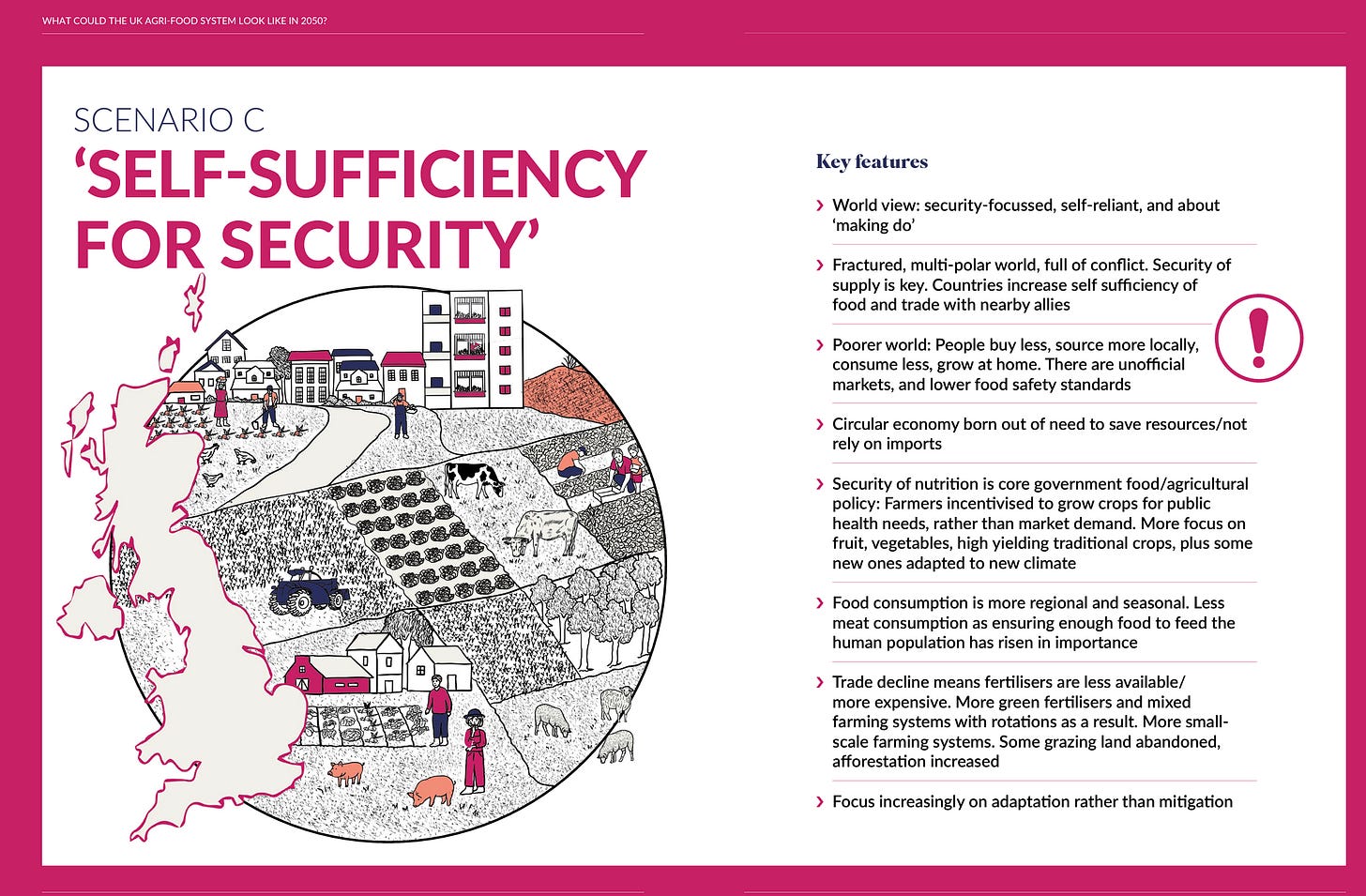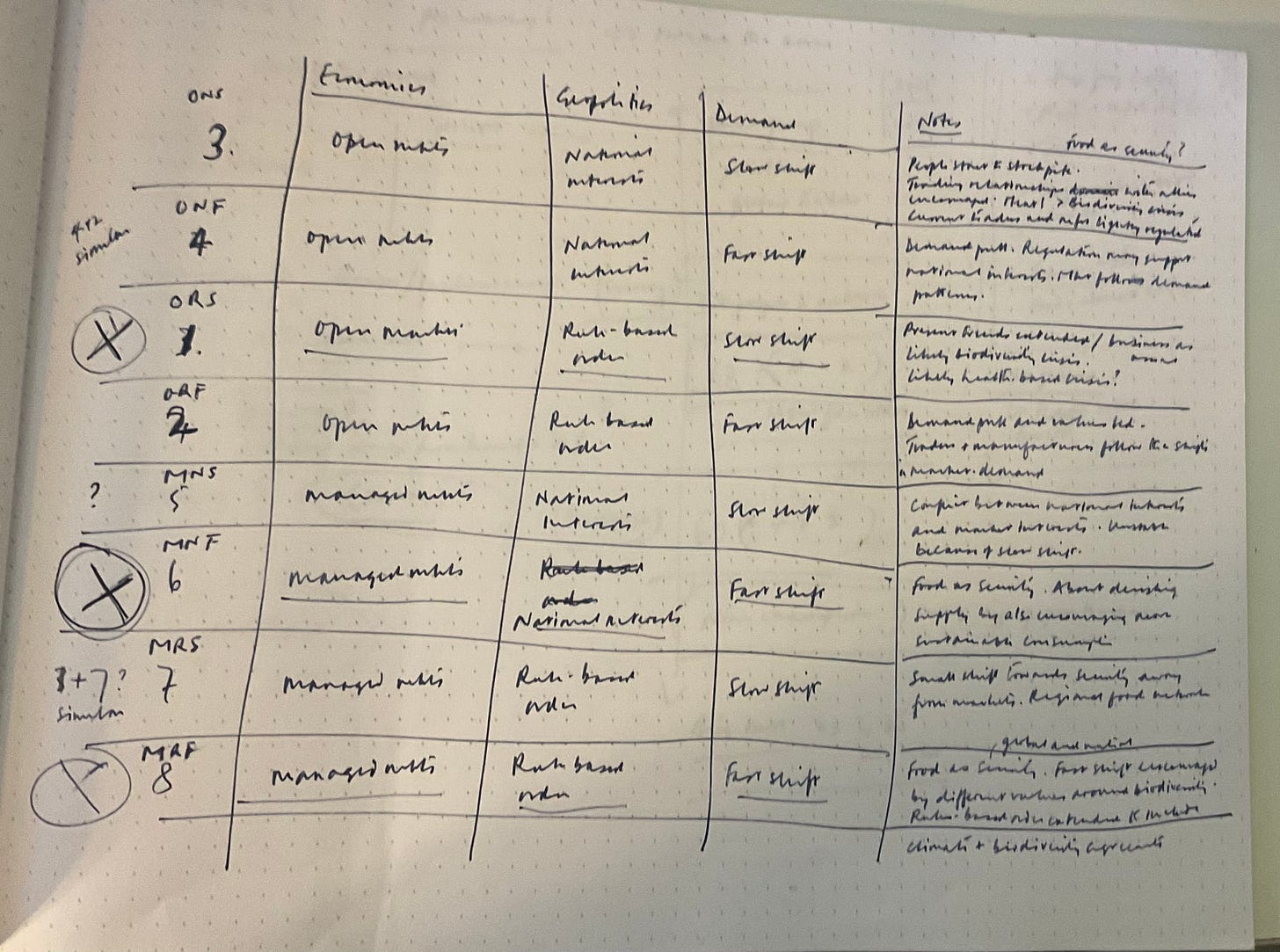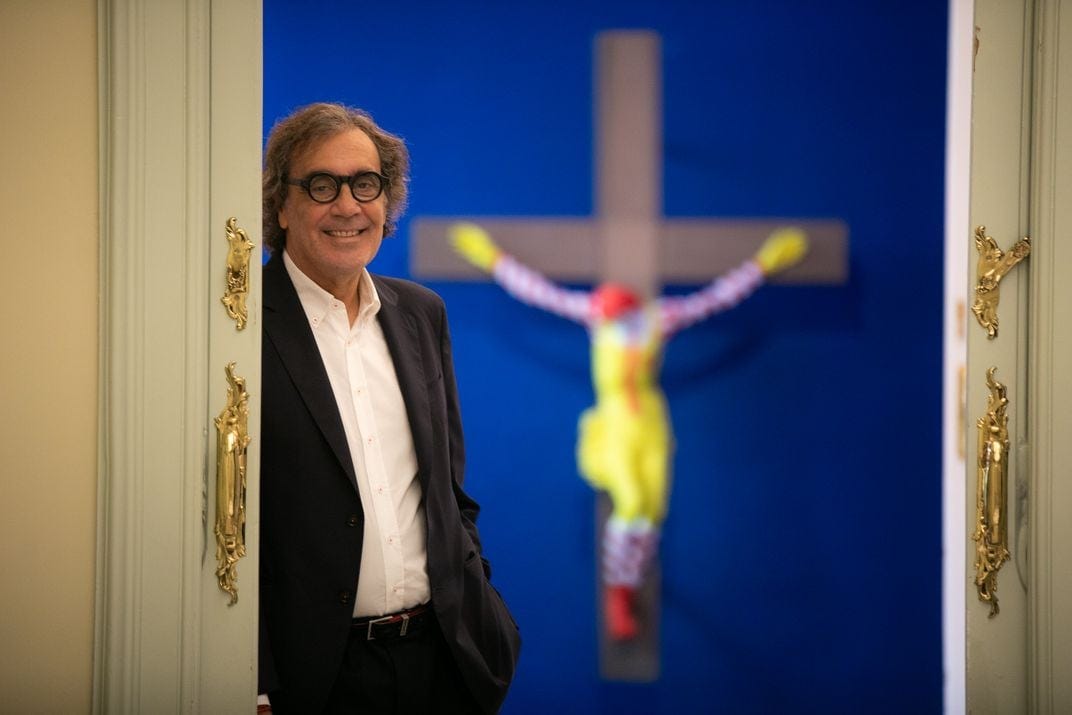28 October 2023. Food | Art
Imagining the futures of food in a net-zero world // The museum of banned and suppressed pictures.
Welcome to Just Two Things, which I try to publish three days a week, although haven’t quite managed that recently while on a rush of work. Some links may also appear on my blog from time to time. Links to the main articles are in cross-heads as well as the story. A reminder that if you don’t see Just Two Things in your inbox, it might have been routed to your spam filter. Comments are open. And—have a good weekend!
1: Imagining the future of food in a net zero world
Earlier this year I worked with the UK Agri-foods for Net Zero Network (AFN for short) to help them develop a set of scenarios about the future of food production and consumption. The group includes academics, practitioners, and policy-makers. The purpose of the scenarios was to stretch their thinking around the types of research that could help to accelerate the transition of the sector to Net Zero.
(Source: AFN)
The project report was published this week, and so I am able to share the scenarios and some of the methodology here.
The scenarios first, though: four emerged from the process, which is their final iteration are called ‘Build Back Fast Again’; ‘Circular Worlds’; ‘Self-Sufficiency for Security’; and ‘The Right to Food’.
The pdf has a little infographic that summarises them.
(Source: Benton et al, ‘What could the UK agri-food system look like in 2050?’ AFN. The numbers are page numbers).
The first of these is, generally, a ‘business as usual’ scenario, with large global agricultural corporations running the show, and governments relying on world markets to feed themselves. It is in there, as with so many BAU scenarios, to test whether this is a sustainable future. In short: it is not. And since there is a good visual summary of each of the scenarios in the report, I’m just going to paste in the spreads as I go, rather than describe each scenario at length.
(Source: Benton et al, ‘What could the UK agri-food system look like in 2050?’ AFN.)
The second, ‘Circular Worlds’, draws on ideas about agro-ecology. All of these workshops took place under a version of the Chatham House Rule, and so I shouldn’t say who spoke to this scenario as it was being developed, but the report notes that Bob Costanza is one of the group’s Network+ champions, so you can probably draw your own conclusions.
I’m not sure that we quite bottomed out the productive capacity of this scenario—that may become one of the research questions—although this topic is the subject of a live and acrimonious debate at the moment between Chris Smaje (who thinks yes) and George Monbiot (who disagrees). Neither of them were involved in the process, by the way.
(Source: Benton et al, ‘What could the UK agri-food system look like in 2050?’ AFN.)
The third scenario is driven by food security, in a world where food imports are erratic and governments know that hungry citizens lose patience with them. (Perhaps the moving spirit behind this scenario is Andrew Simms’ notion that we are ‘nine meals away from anarchy’). FN Andrew Simms wasn’t involved in the process either.
(Source: Benton et al, ‘What could the UK agri-food system look like in 2050?’ AFN.)
I was involved in stewarding the fourth scenario (it’s unattributable, but I think I am allowed to out myself), and it was striking how hard it was to get this to a position where it was stable and didn’t keep converging with Scenario A, the big business ‘Build Back Fast Again’.
The reason for this is that it requires businesses that are values-driven, and those participating in the workshops found it hard to imagine this world. (When you watch the actual behaviour of the large food sector businesses, as most of them lobby hard against the lightest public health-driven regulatory intervention, it is possible to understand why this might be.)
Although I am not in general a fan of the conventional wisdom that says scenarios need to have both a future story and a coherent path that gets you from here to there (FN Long story short: there’s research that suggests that this narrows our cognitive ability to imagine a broader range of possible futures), in the end it was necessary here. The path involved a combination of tough national anti-trust/ anti-monopoly legislation, and a shift in values in which the idea of purposeful business became much more central. (Because values change over time, and Gen Zs and Millennials will be running these businesses long before 2050).
Here’s this scenario:
(Source: Benton et al, ‘What could the UK agri-food system look like in 2050?’ AFN.)
It’s worth going back briefly to discuss the process. We started with a 2 x 2 x 2 matrix that created eight possible scenarios, based on existing research that suggests that there are three big uncertainties:
Geopolitics and stability: Will the world be more volatile, conflicted and contested or return to cooperative, rules-based and calmer?
Economics: Will we rediscover open, global markets and drive back towards globalisation, or move towards more regionalised, regulated and securitized markets?
Demand: consumption-based growth or more sustainability: How will demand for the goods from land evolve? Will it grow unfettered, or will it decouple from resource demand, through price signals and sector or system innovation?
Obviously eight scenarios is too many to work with, so we removed scenarios that seemed incoherent or looked similar and less interesting than another one. (FN The formal set of criteria is described in an Annex to the report.) As it happens, I found my worksheet for this last week.
(Source: Andrew Curry. CC BY-NC-SA 4.0).
The first in-person/hybrid workshop built out a set of scenarios from a set of sketches by looking at food through an international and geo-political lens. The second—shorter and online—use Verge to bring the scenarios to life in a UK context, and the third, also online, used Three Horizons to explore emerging questions in the H2 space.
It’s not included in the report for space reasons, but I also did a validation exercise to ensure the diversity of the final scenarios set. They map well onto James Dator’s four emerging futures (Growth, Transformation, Collapse, Discipline, respectively). I also used Sagiv’s cultural and social values pairs (see page 9) as a second test: again, each scenario corresponds to a different one of the four combinations.
In terms of the project outcomes, it was about assessing future research needs. The report observes that these are quite different from current perspectives as soon as you move away from the ‘Business as Usual’ scenario:
It is agro-ecologically intensive in Scenario D (‘The right to food’) and features smaller, more diverse, mixed, low-synthetic-input systems in Scenarios B (‘Circular worlds’) and C (‘Self-sufficiency for security’). All also have increased circularity. Should we be preparing, through funding our R&D and innovation ecosystems, for different forms of agriculture (different crops, grown in different ways, within different farming systems, in different amounts) to ensure we are ‘future-ready’, whatever the future holds?
The second observation is that—contrary to pessimistic views of the future—some of these scenarios are normatively better social futures:
Are we investing enough in understanding and unlocking system transformation from the more dysfunctional futures (Scenarios A, C) to the more equitable ones (B and D). In the midst of this, how can we prioritise pathways that maximise co-benefits for human health and biodiversity?
As the report concludes: it would be good to get to Net Zero. And it would be better to get there “in a more socially just world.”
2: The museum of banned and suppressed pictures
Barcelona’s new Museu de l’Art Prohibit has been getting some coverage recently. It is the brainchild of a Catalan art collector and businessman Tatxo Benet, and he seems to have paid for the building and bought the 200 works that represent its collection.
(Tatxo Benet. Finnish artist Jani Leinonen's McJesus is in the background. Photo: Museu de l’Art Prohibit)
As you might have guessed from the name, the collection involves works that have been banned or censored, or have been embroiled in controversy. He started collecting this kind of work in 2018. He bought a work by Santiago Sierra called ‘Political Prisoners in Contemporary Spain’, which was removed from ARCOmadrid, an important art fair, 24 hours before it was due to open.
At the time ArtNews reported that
the work consists of 24 black-and-white photographs of politicians, activists, artists, and journalists whose faces have been obscured. Although they are not named in the work, the subjects are identifiable. They include politicians and activists supporting Catalan Independence who are under arrest and face charges of sedition and rebellion, according to Spanish sources.
The request came from the President of the organisation that runs Madrid business fairs, rather than the authorities. Benet told the Art Newspaperthat he bought it to make the banned work available to see in Spain.
“I only want to re-establish the right of anyone to see that piece of art,” he tells us. “I knew that the piece was powerful but I would never have imagined it would be censored. This is one of the motives of Modern art: to generate debate.”
The full collection of the Museu d l’Art Prohibit includes work by Ai WeiWei, Banksy, and Gustav Klimt. Like the Santiago Sierra, WeiWei’s work has typically been censored for political reasons. Some of the controversies here manage to mix politics and sex, or sex and religion.
For example the collection includes a portrait of the Mexican revolutionary leader Emiliano Zapata, riding a horse naked except for a pink sombrero and a pair of stillettos. ‘Con Flores A Maria’, by the Spanish artist Charo Corrales, appears at a casual glance to be a conventional painting of the Virgin Mary, her eyes raised to the heavens, except that her hand is between her legs.
A report in the Guardian focussed on genfer themes in the exhibition:
The French-Algerian artist Zoulikha Bouabdellah and the Kazakhstani Zoya Falkova make powerful statements about the status of women in their respective countries. Bouabdellah’s Silence Rouge et Blue consists of 30 prayer mats, each adorned with a pair of sequinned stillettoes. In a comment on male violence, Falkova’s Evermustconsists of a black leather boxer’s punchbag, except her version is in the shape of a woman’s torso.
'Evermust’ was exhibited in the first “Feminnale” of contemporary art at the National Museum of Fine Arts in Kyrgyzstan, but the government ordered it, and a number of other works to be taken down.
Benet also acquired a number of works by Guantanamo prisoners that had provoked complaints when they were shown in public. In response the US government had ruled that hereon a prisoners artworks should be destroyed on release:
”Their story is important,” says Benet. “Exhibiting them here means they have, in effect, been liberated.”
Reading this collection of stories about the Museu one thing that is notable is the power of the Crucifixion to shock. There’s an image here of Raquel Welch on a cross, shot by Terry O’Neill after she had said that she had been “crucified” for her role in One Million Years BC. The shoot was paid for by 20th Century Fox, but they decided against using them. There’s also ‘McJesus’, an image of Ronald McDonald of McDonald’s, on a cross, and a striking image by the Argentinian artist Leon Ferrari called ‘Western Christian Civilization’.
(Leon Ferrari, ‘Western Christian Civilisation’. Photograph: Museu de l’Art Prohibit.)
The painting dates from the time of the Vietnam War, but also encapsulates much of the colonial history of the Global South.
Benet sees that museum as being about asserting the value of freedom of expression:
“That’s what these works have in common, and it shows that censorship has failed because here you can see them,” he says.
But there’s maybe a bigger story that sits behind it. Given the topics that emerge repeatedly—religion, sexuality, gender freedoms, freedom of political expression, and so on—you can also see the existence of this museum as another expression of the fault line in the fight between social progress and tradition, that is being played out in both national politics and geopolitics at the moment. It wouldn’t stay open long in Russia (I wrote about Russia’s war on modernity here a couple of months ago). Or Florida, come to that.
j2t#508
If you are enjoying Just Two Things, please do send it on to a friend or colleague.












Harry, They told me that it was due to be published last week, and that it would be on the website. I can’t see it either, so I have asked them for an update. I’ll share the link when I have it.
— Best wishes, Andrew
Many thanks for yet another excellent post. Do you have a link for the AFN report please? I can't find to on their website.